- Joined
- 27 Jan 2008
- Messages
- 25,816
- Reaction score
- 3,062
- Location
- Llanfair Caereinion, Nr Welshpool
- Country

However, are there not caravans in which all of the touchable parts are non-conductive (e.g. fibreglass) and, if so, why do special regs apply to hem?
Where I work, the building is RSJ's with steel cladding, with at least three independent three-phase TN-C-S supplies, which clearly should be outlawed, but in real terms there is that much metal in the ground, 8 miles of railway track to start with, it is highly unlikely even with a loss of PEN the building would raise in polarity to true earth by any significant level.
But the regulations are not doing a risk assessment on every caravan, my father-in-law stated the meter cupboard was 1.5 meters from the caravan, and to have the caravan on a different earthing system to the house was dangerous, and he was likely correct.
But unless like my father-in-law you can show good reason not to comply, then you're stuck, TN-C-S not permitted to caravans and similar items, but for an EV car as long as a loss of PEN detection is used, you can, god knows what regulations cover an EV motor caravan?



